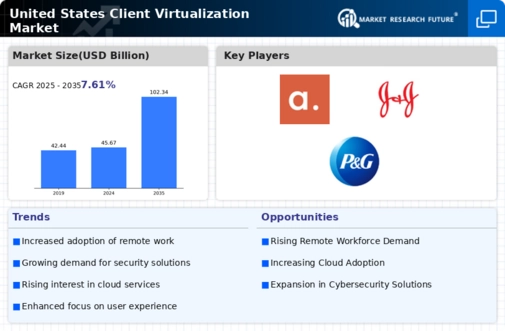Growing Emphasis on Data Security
Data security is an increasingly critical concern for organizations, driving growth in the client virtualization market. With the rise of cyber threats and data breaches, businesses are prioritizing solutions that enhance security measures. Virtualization technologies offer robust security features, such as centralized management and data encryption, which help protect sensitive information. In the US, nearly 75% of organizations report that data security is a top priority in their IT strategy. This heightened focus on security is likely to lead to increased investments in client virtualization solutions that provide secure access to applications and data. As organizations seek to mitigate risks associated with data breaches, the client virtualization market is poised for growth, as it offers a viable solution to address these pressing security challenges.
Integration of Emerging Technologies
The integration of emerging technologies is a significant driver in the client virtualization market. As organizations seek to enhance their operational efficiency, they are increasingly adopting technologies such as artificial intelligence (AI), machine learning, and the Internet of Things (IoT). These technologies can be integrated with virtualization solutions to improve performance and user experience. For instance, AI can optimize resource allocation and enhance security protocols within virtual environments. As of November 2025, Approximately 50% of US companies are exploring the integration of AI with their virtualization strategies. This trend suggests that the client virtualization market will continue to evolve. This trend suggests that the client virtualization market will continue to evolve, as organizations leverage emerging technologies to create more efficient and secure virtual environments. The potential for innovation in this space is substantial, indicating a promising future for client virtualization solutions.
Cost Efficiency and Resource Optimization
Cost efficiency remains a pivotal driver in the client virtualization market. Organizations are increasingly seeking ways to optimize their IT expenditures while maintaining high levels of performance and security. Virtualization solutions allow companies to reduce hardware costs by enabling multiple virtual machines to run on a single physical server. This consolidation can lead to savings of up to 30% in IT infrastructure costs. Furthermore, the ability to manage resources more effectively contributes to lower operational expenses. As businesses in the US continue to prioritize budgetary constraints, the client virtualization market is likely to see sustained growth. The potential for significant cost savings, combined with the ability to streamline IT operations, positions virtualization as an attractive option for organizations aiming to enhance their financial performance.
Advancements in Cloud Computing Technologies
The client virtualization market is significantly influenced by advancements in cloud computing technologies. The increasing adoption of cloud services allows organizations to leverage virtualization solutions that enhance scalability and flexibility. As of November 2025, Approximately 60% of US businesses utilize cloud-based solutions. This trend facilitates the deployment of client virtualization technologies. This trend indicates a shift towards hybrid and multi-cloud environments, where organizations can seamlessly integrate various cloud services with their existing infrastructure. The ability to access virtual desktops and applications from any location, coupled with the scalability offered by cloud solutions, positions client virtualization as a vital component in the digital transformation journey of businesses. The ongoing evolution of cloud technologies is expected to further propel the growth of the client virtualization market.
Rising Demand for Flexible Work Environments
The client virtualization market experiences a notable surge in demand for flexible work environments. Organizations are increasingly recognizing the need for solutions that enable employees to work from various locations without compromising productivity. This shift is driven by the desire for enhanced work-life balance and the need to attract top talent. According to recent data, Approximately 70% of companies in the US have adopted some form of remote work policy. This trend directly influences the growth of the client virtualization market. As businesses seek to implement effective remote work strategies, the demand for virtualization solutions that facilitate seamless access to applications and data from any device is likely to increase. This trend underscores the importance of adaptability in the workplace, positioning client virtualization as a critical component in modern organizational strategies.














Leave a Comment